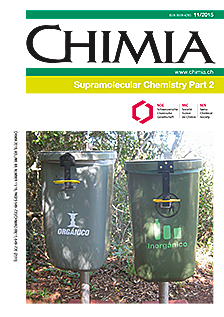Resolving the Magnetic Asymmetry of the Inner Space in Self-assembled Dimeric Capsules Based on Tetraurea-calix[4]pyrrole Components
DOI:
https://doi.org/10.2533/chimia.2015.652Keywords:
Calix[4]pyrrole, Magnetic asymmetry, Molecular encapsulation, Supramolecular chiralityAbstract
The encapsulation of N,N, N',N'-tetramethyl-1,5-pentanediamine-N,N'-dioxide 2 in a non-chiral capsular assembly formed by dimerization of tetraurea-calix[4]pyrrole 1a produced the observation of the N-methyl groups of the encapsulated guest as two separated singlets resonating highly upfield in the 1H NMR spectrum. In order to clarify the origin of the observed signal splitting we assembled and studied a series of structurally related dimeric capsules. We used the tetraurea-calix[4]pyrrole 1a , the enantiomerically pure tetraurea-calix[4] pyrrole R-1b and the tetraurea-bisloop calix[4]pyrrole 1c as components of the produced assemblies. The 1H NMR spectra of the assembled encapsulation complexes with bis-N-oxide 2 evidenced diverse splitting patterns of the N-methyl groups. In addition, 2D EXSY/ROESY NMR experiments revealed the existence of chemical exchange processes involving the separated methyl signals of the encapsulated guest. The capsular assemblies were mainly stabilized by a belt of eight head-to-tail hydrogen-bonded urea groups. The interconversion between the two senses of rotation of the unidirectionally oriented urea groups was slow on the 1H NMR timescale. These characteristics determined the appearance of a new asymmetry element (supramolecular conformational chirality) in the assemblies that accounted for some of the magnetic asymmetries featured by the capsule's inner space. The racemization of the supramolecular chirality element was fast on the EXSY timescale and produced the chemical exchange processes detected for the encapsulation complexes.Downloads
Published
2015-11-25
How to Cite
[1]
M. Espelt, G. Aragay, P. Ballester, Chimia 2015, 69, 652, DOI: 10.2533/chimia.2015.652.
Issue
Section
Scientific Articles
License
Copyright (c) 2015 Swiss Chemical Society

This work is licensed under a Creative Commons Attribution-NonCommercial 4.0 International License.







